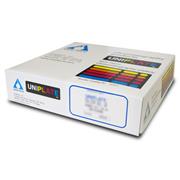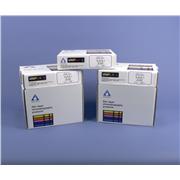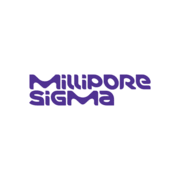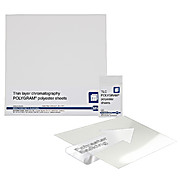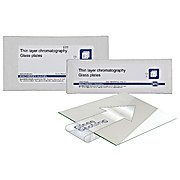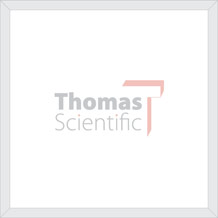TLC Plates
-
ADAMANT Unmodified Standard Silica Layers for TLC
MACHEREY-NAGELFeatures Silica 60, specific surface (BET) ~ 500 m2/g, mean pore size 60 Å, specific pore volume 0.75 mL/g, particle size 5–17 µm Outstanding hardness and abrasion resistance due to an optimized binder system Increased separation efficiency due to an optimized particle…
-
TLC Developing Tank
DWK Life Sciences (Kimble)Constructed of sturdy molded glass bricks Withstands regular use for many years The tank’s clear sides allow for visual inspection of TLC plates up to 20 x 20 cm size. The top of the tank is ground flat to match the lids and the edges are beveled to remove any sharp edges. The bottoms are…
-
Silica Gel HL UNIPLATES
Miles Scientific (Analtech)These are the most rugged silica gel plates available. They not only ease handling and sample application, but also permit the use of up to 80% water in the developing solvent without loss of adherence of the adsorbent layer to the glass plate. Organic binder plates are recommended for all TLC…
-
Avicel F UNIPLATES
Miles Scientific (Analtech)These plates are coated with AVICEL microcrystalline cellulose manufactured by the American Viscose division of FMC Corp. The adsorbent consists of regenerated alpha cellulose particles of nearly spherical shape and 50 micron mean diameter.
-
TLC Kieselguhr F254
MilliporeSigmaPrecoated Kieselguhr or mixed Silica gel/Kieselguhr plates are only of small importance nowadays. Kieselguhr layers are used like cellulose layers for the TLC separation of polar and moderately polar substances. Polyamide, on the other hand , is used for the separation of flavonoids and other…
-
Legal Information Aldrich is a registered trademark of Sigma-Aldrich Co. LLC
-
Silica Gel HLF UNIPLATES
Miles Scientific (Analtech)These are the most rugged silica gel plates available. They not only ease handling and sample application, but also permit the use of up to 80% water in the developing solvent without loss of adherence of the adsorbent layer to the glass plate. Organic binder plates are recommended for all TLC…
-
TLC Silica gel 60 F254 GLP
MilliporeSigmaThese plates feature individual laser coding for GLP applications. Designed for GLP applications, the tops of each of these plates bear an item, batch, and individual plate number. As a result, lab professionals can easily record and archive every plate they use. Based on proven EMD Millipore…
-
TLC SILICA GEL 60 RP-8 F254S 50 GLASS PLATES 10 X 20 CM
MilliporeSigmaRP modified plates serve two purposes: act as a pilot method for HPLC and allow to choose various solvent system for special separations. RP-modified silica layers from EMD Milliporeare well suited for many separation challenges that unmodified silica cannot overcome. These layers use aqueous…
-
HPTLC Silica gel 60 F254 GLP
MilliporeSigmaThese plates feature individual laser coding for GLP applications. Designed for GLP applications, the tops of each of these plates bear an item, batch, and individual plate number. As a result, lab professionals can easily record and archive every plate they use. Based on proven EMD Millipore…
-
SIL G Unmodified Standard Silica Layers for TLC
MACHEREY-NAGELSilica 60, specific surface (BET) ~ 500 m 2 /g, mean pore size 60 Å, specific pore volume 0.75 mL/g, particle size 5–17 µm; standard grade Thickness of layer for analytical plates 0.25 mm, for preparative plates 0.5 and 1 mm For 2 mm preparative layers a slightly coarser…
-
HPTLC silica gel 60
MilliporeSigmaHPTLC plates deliver fast and quantitative analysis of complex samples for manual or automated use. EMD Millipore’s HPTLC silica plates work three times faster than conventional TLC plates – and they’re more sensitive. The particle sizes range in HPTLC is between 4-8µm, which creates a smoother…
-
TLC Silica Gel 60
MilliporeSigmaClassical silica TLC plates are based on a combination of proven EMD Millipore silica gel 60 and the addition of a unique polymeric binder resulting in a very adherent and hard surface that will not crack or blister and even allow writing with a pencil on the surface without risk to damage the…
-
TLC Cellulose
MilliporeSigmaCellulose plates are used to analyze polar substances. An organic sorbent, cellulose is perfect for separating hydrophilic substances by partition chromatography. Typical applications include the analysis of amino acids, carbohydrates, and phosphates as well as nucleic acid and nucleic acid…
-
TLC Silica gel 60 with Concentrating Zone 20 x 2.5 cm
MilliporeSigmaThese plates allow users to quickly and easily apply any kind of sample, even large volumes of diluted samples. EMD Millipore concentrating zone plates are based on different adsorption properties of two adsorbents. The first is a large pore concentrating adsorbent where the samples are applied;…
-
Nano-SIL CN Cyano-Modified HPTLC Silica Layers
MACHEREY-NAGELFeatures Base material: Nano silica 60, specific surface (BET) ~ 500 m 2 /g, mean pore size 60 Å specific pore volume 0.75 mL/g particle size 2–10 μm pH stability 2–8 Indicator: acid-resistant product with a pale blue fluorescence for short-wave UV…
-
DURASIL Unmodified Standard Silica Layers for TLC
MACHEREY-NAGELFeatures Silica 60, specific surface (BET) ~ 500 m2/g, mean pore size 60 Å, specific pore volume 0.75 mL/g, particle size 5–17 µm Hard, water-resistant and wettable layers due to a special binder system No reversed phase tendency, more polar than SIL G Available as…
-
TLC SILICA GEL 60 RP-18 F254S 50 GLASS PLATES 5 X 20 CM
MilliporeSigmaRP modified plates serve two purposes: act as a pilot method for HPLC and allow to choose various solvent system for special separations. RP-modified silica layers from EMD Millipore are well suited for many separation challenges that unmodified silica cannot overcome. These layers use aqueous…
-
10 cm Latch-Lid Chromatotank
General Glass BlowingRequires less solvent to maintain equilibrium Gives excellent retention of solvent saturated chamber Holds two 10 x 10 cm plates The smaller cubic inch chamber allows for a faster and more uniform solvent-saturated atmosphere. Single molded tank has a flat ground top, beveled for…
-
Nano-DURASIL Unmodified HPTLC Silica Layers
MACHEREY-NAGELFeatures Nano silica 60, specific surface (BET) ~ 500 m2/g, mean pore size 60 Å, specific pore volume 0.75 mL/g, particle size 2–10 µm Indicator: manganese activated zinc silicate with green fluorescence for short-wave UV (254 nm) Hard, water-resistant and wettable…
-
HPTLC Silica Gel 60 Multiformat Pre-scored to 5 x 5 cm
MilliporeSigmaHPTLC plates deliver fast and quantitative analysis of complex samples for manual or automated use. EMD Millipore’s HPTLC silica plates work three times faster than conventional TLC plates – and they’re more sensitive. The particle sizes range in HPTLC is between 4-8µm, which creates a smoother…
-
HPTLC Silica Gel 60
MilliporeSigmaPlates deliver fast and quantitative analysis of complex samples for manual or automated use. EMD Millipore’s HPTLC silica plates work three times faster than conventional TLC plates – and they’re more sensitive. The particle sizes range in HPTLC is between 4-8µm, which creates a smoother surface…
-
HPTLC SILICA GEL 60 RP-18 W 25 GLASS PALTES 10 X 20 CM
MilliporeSigmaRP modified plates serve two purposes: act as a pilot method for HPLC and allow to choose various solvent system for special separations. RP-modified silica layers from EMD Millipore are well suited for many separation challenges that unmodified silica cannot overcome. These layers use aqueous…
-
Rectangular Developing Chambers
General Glass BlowingThe single most useful chamber for the TLC laboratory is a sturdy, molded-glass block of clear glass with flat surface walls, ground lip of uniform flatness, beveled inside and outside to remove any sharp edges. There is a raised ridge midway on the inside ends and bottom of the jar. Inside…
-
TLC SILICA GEL 60 F254 50 ALUMINIUM SHEETS 5 X 10 CM
MilliporeSigmaEMD Millipore classical silica TLC plates are based on a combination of proven EMD Millipore silica gel 60 and the addition of a unique polymeric binder resulting in a very adherent and hard surface that will not crack or blister and even allow writing with a pensil on the surface without risk to…
-
Reversed Phase Octadecyl Silanized Silica Gel UNIPLATES
Miles Scientific (Analtech)These reversed phase TLC plates have been manufactured to be greater than 50% and less than 100% silanized. Because of this they are hydrophobic, but wettable. Features: 14% carbon content Acid stable (UV254) fluorescent indicator Glass backing 250um coating thickness 25…
-
HPTLC Silica Gel 60
MilliporeSigmaThese plates deliver fast and quantitative analysis of complex samples for manual or automated use. EMD Millipore’s HPTLC silica plates work three times faster than conventional TLC plates – and they’re more sensitive. The particle sizes range in HPTLC is between 4-8µm, which creates a smoother…
-
RP-18 W/UV254 Octadecyl-Modified HPTLC Silica Layers
MACHEREY-NAGELFeatures Base material: silica 60, specific surface (BET) ~ 500 m2/g, mean pore size 60 Å specific pore volume 0.75 mL/g particle size 2–10 μm for preparative plates (1 mm thickness of layer) standard silica 60 particle size 5–17 µm pH stability…
-
TLC Silica Gel 60 F254 Multiformat Pre-scored to 5 x 10 cm
MilliporeSigmaPre-scored glass plates fold into smaller formats with just one easy snap of the fingers. HS Code: 3822 00 00
-
TLC Cellulose F
MilliporeSigmaCellulose plates are used to analyze polar substances. An organic sorbent, cellulose is perfect for separating hydrophilic substances by partition chromatography. Typical applications include the analysis of amino acids, carbohydrates, and phosphates as well as nucleic acid and nucleic acid…
-
TLC Silica gel 60 F254
MilliporeSigmaClassic silica TLC plates are based on a combination of proven EMD Millipore silica gel 60 and the addition of a unique polymeric binder resulting in a very adherent and hard surface that will not crack or blister and even allow writing with a pensil on the surface without risk to damage the layer.
-
HPTLC-RP8F UNIPLATES
Miles Scientific (Analtech)The availability of both normal phase and Reversed Phase HPTLC UNIPLATES completes HPTLC as a sensible, efficient and cost effective alternative technique for quantitative analysis. These Reversed Phase adsorbents share the features and benefits of silica gel HPTLC plates: high efficiency…







